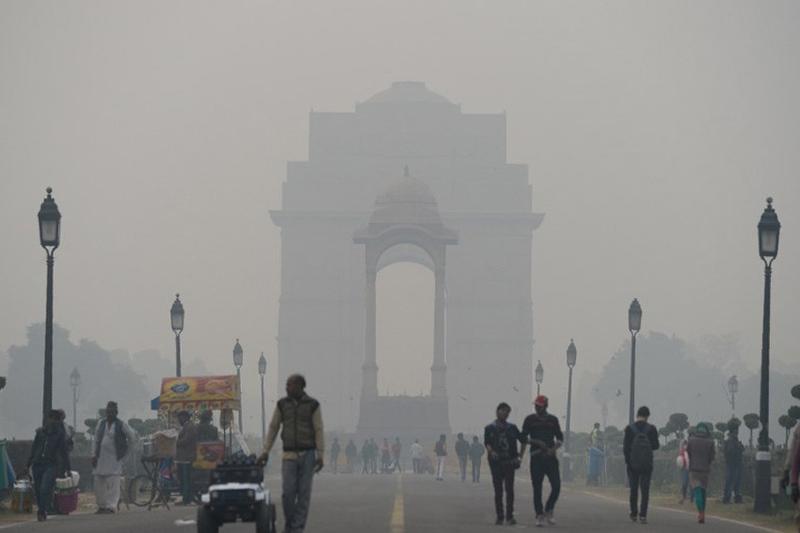NEW DELHI: Despite efforts being made to curb pollution in the country, India’s list of most polluted cities is continuously growing. According to a recent report released by the Swiss Technology firm, IQAir, India houses 65 of the top 100 most polluted cities in the world, giving rise to questions over efforts being made by several governments not being implemented on the ground.
The report by IQAir’s most polluted cities in the world, 2022, states that six Indian cities fall under the top 10 most polluted cities in the world. However, the first position for the most polluted cities in 2022 went to Lahore, Pakistan, while the second position was taken by Bhiwadi, Rajasthan.
Delhi came fourth in the list of world’s most polluted cities in 2022. The current and live data from the IQAir shows that currently, Delhi is the world’s most polluted city. The other Indian cities that made to the top 10 list of polluted cities in the world includes, Dharbhanga, Asopur, Patna, Chapra in Bihar, Ghaziabad, Uttar Pradesh and Dhaurehera, Haryana, while Noida, the adjoining city of Uttar Pradesh to Delhi, is ranked the 13th most polluted city in the world. The unchecked air pollution in the country is causing massive long-term health implications amongst the population. Doctors as well as researchers have been time and again cautioning governments to ensure that good quality air is ensured in Indian cities. But despite the government and the Ministry of Environment taking steps to clean the air we breathe, most cities have shown little or no improvement in the ambient air quality. A research by The Centre for Research on Energy and Clean Air (CREA) shows that though many large cities have the Graded Response Action Plan (GRAP) laid down, most of these cities are not being able to implement the same when the need arises.
The report, “Status Assessment of Graded Response Action Plan Implementation in the Indo-Gangetic Plain”, highlights the poor, and sometimes entirely lacking, infrastructure and a systematic plan to mitigate the emission of toxic pollutants during heavy pollution days.
Between October 2022 and February 2023, the PM 10 concentration in the ambient air we are breathing has been more than 15 times than the prescribed World Health Organisation standards for ambient air quality. According to the report by CERA, Begusarai, Katihar, Chapra, Dharbhanga, Sharsha and Samistipur, all cities in Bihar had PM 10 levels which was more than 300 on an average. This falls under severe category of air quality, where outdoor activities are prohibited. The PM 2.5 levels were equally bad in these cities.
The Delhi NCR region, which includes the satellite cities of Noida, Ghaziabad and Faridabad, recorded its PM 10 and PM 2.5 levels more than 250 and 150 respectively, between October 2022 and February 2023, which falls under the very poor category. Delhi also witnessed 78 days of very poor air quality, and three days of severe plus and six days of severe air quality in the said period.
“In the Indo-Gangetic plains, 26 cities have reported PM2.5 levels under the ‘Severe+’ category, 38 cities reported ‘Severe’ and 78 cities had ‘Very Poor’ air quality. Out of 85 cities and towns, only seven cities reported AQI levels better than ‘Very Poor’ category from October 1, 2022, to February 15,” the CERA report stated.
The report also further says that despite the national Graded Response Action Plan (GRAP) formulated by the Central Pollution Control Board, most of the cities have failed to implement the same when the air quality in these cities plummeted to poor or very poor category.
The GRAP, first launched in 2017 only for NCR, is a set of protocols to mitigate emissions of toxic pollutants from various sources based on prevailing ambient air pollution. Subsequently, the National Green Tribunal directed all states to formulate a GRAP for all non-attainment cities (NAC). Of the 131 NACs in the country, 39 are in the IGP region. Five of these are situated within the NCR.
Sunil Dahiya, co-author of the report, told The Sunday Guardian that when they were studying the pollution levels, they found that apart from the Delhi-NCR region, no other cities have followed the GRAP guidelines, which includes graded emergency response to tackle pollution. Some of the actions include shutting of schools, industries, odd-even for vehicular movement, coal based industries, among others.
“We have seen that almost all the 26 non-attainment cities across the country did not implement GRAP despite having severe plus air quality in these cities. We have only notices that Delhi-NCR has been able to follow the GRAP guidelines to an extent. We have also noticed that none of the other cities even publicly announced or advertised through social media or through conventional media about the implementation of GRAP during the poor or severe air quality conditions in those cities. This shows the apathy of the local governments who are not interested to tackle the problem of air pollution,” Sunil Dahiya told this newspaper.
Norms not implemented, India has 65 of 100 world’s most polluted cities
- Advertisement -

